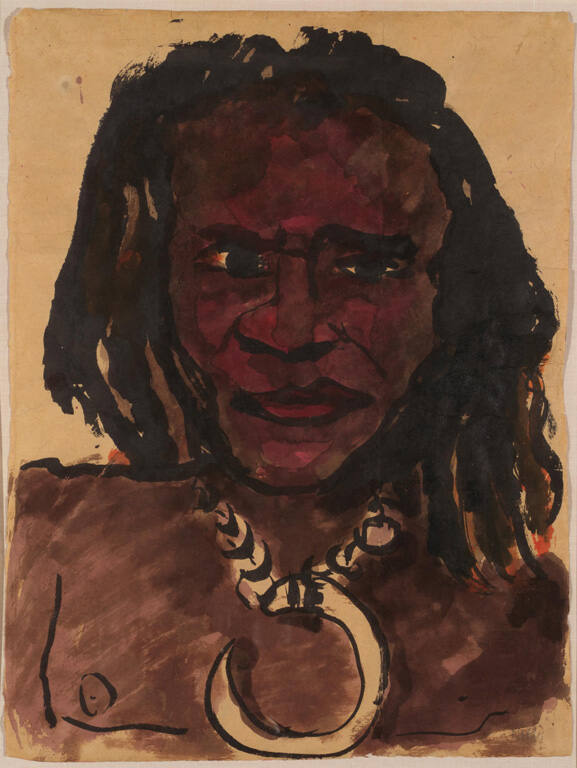
Object Details
Artist
Emil Nolde
Date
1914
Medium
Watercolor
Dimensions
19 1/4 x 14 3/4 inches (48.9 x 37.5 cm)
Credit Line
Acquired through the University Purchase Fund
Object
Number
69.108
Provenance:
1914– collection of the artist. –1969 collection of Serge Sabarsky Gallery, I(…)
Provenance:
1914– collection of the artist. –1969 collection of Serge Sabarsky Gallery, Inc., New York; 1969 collection of Herbert F. Johnson Museum of Art, Cornell University, Ithaca (purchased form Serge Sabarsky Gallery
——
Nolde began his career as a woodcarver in a furniture factory, but after some successful forays into painting, he had, at the age of 38, his first one-man show in Dresden. This would prove a turning point for him; he was invited to join the Die Brücke group of German Expressionists, and, though he remained a peripheral member for the next year and a half, their energy and ideas were liberating for the older but less-experienced Nolde. In 1913 the German Colonial Ministry invited Nolde to join the Kutz-Leber expedition to the South Seas. The intention of this group was to study health standards in New Guinea. Traveling across Russia, Siberia, and Manchuria en route, he filled numerous sketchbooks as well as painting large-scale works, many of which were confiscated by the British at the outbreak of World War I and not returned until many years later. South Sea Islander was probably painted from life rather than executed later in his studio. The figure, facing us directly and with broad, accentuated features, is typical of his portraits from this period. Like many of his contemporaries, Nolde was greatly influenced by African art as well as other “primitive” styles, and that influence can be seen here. He chose a paper native to New Guinea, which necessitated using a much drier brush, because the surface was extremely absorbent and caused the watercolor to bleed easily. His style of broad areas of wash rather than detailed brushstrokes was conducive to working with this paper, and the result is a richly rendered portrait. (From “A Handbook of the Collection: Herbert F. Johnson Museum of Art,” 1998)
Like many of his contemporaries, Nolde became interested in primitive art. When he was invited by the German Colonial Ministry to join the ethnographic and demographic Kutz-Leber expedition to the South Seas, he jumped at the chance. The intention of this group was to study health standards in New Guinea, journeying across Russia, Siberia, and Manchuria. In a letter home Nolde wrote, “All these countries are so unique, the people, the animals, the plants, everything is so strange, not always beautiful, but always interesting.”
Nolde filled numerous sketchbooks with images from these exotic places, the most intriguing being the monumental heads of some of the men and women he met along the way. For South Sea Islander he chose an absorbent paper native to New Guinea, which necessitated using a much drier brush to keep the watercolor from bleeding easily. Using broad areas of wash rather than detailed brushstrokes proved ideal for working with this paper. (“Drawing the Line: 150 Years of European Artists on Paper,” curated by Nancy E. Green and presented at the Johnson Museum January 20–June 10, 2018)












